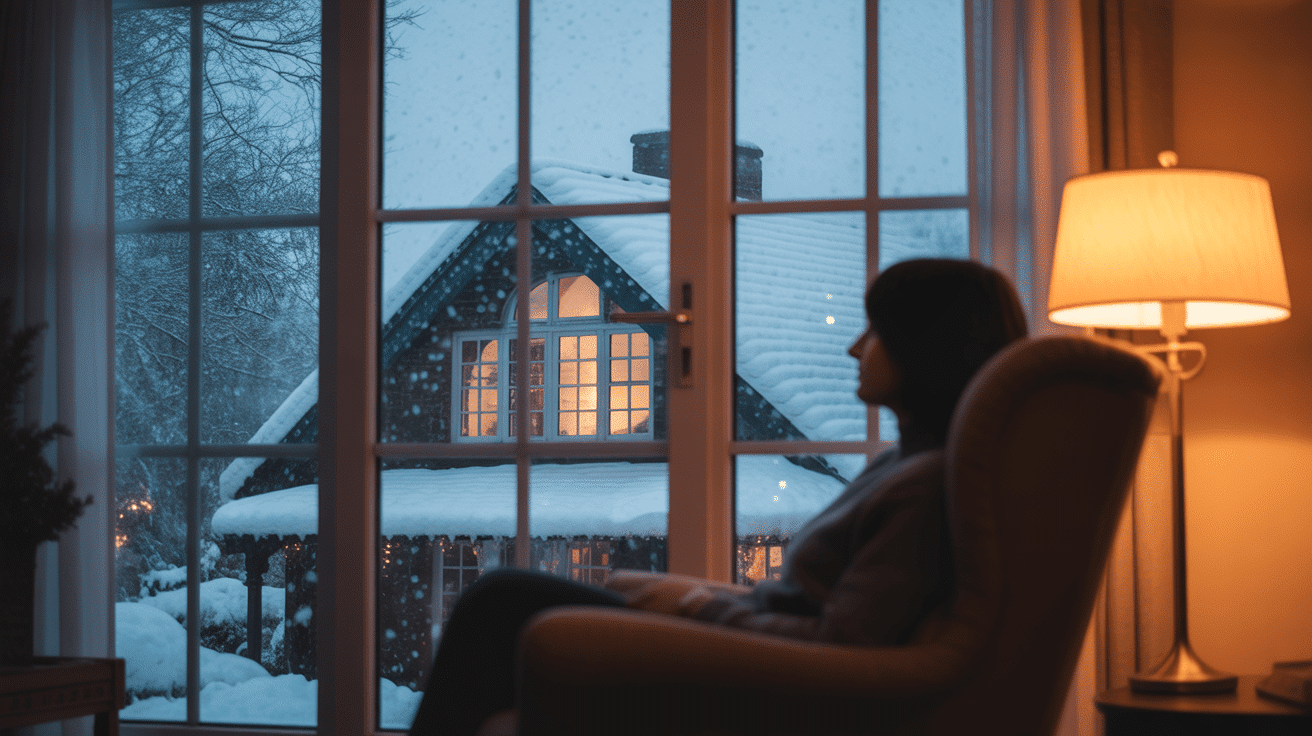Ever watched snow silently pile up on your roof and wondered: “Will my home survive this winter?”
Your roof’s pitch isn’t just a structural detail – it’s your first line of defense against winter’s crushing weight.
Snow accumulation can add thousands of pounds to your roof overnight, turning a beautiful snowfall into a structural nightmare.
The angle of your roof determines whether snow slides off harmlessly or builds up dangerously. A properly pitched roof works silently in the background, protecting everything beneath it without a second thought.
This guide cuts through the confusion to help you identify the perfect roof pitch for your snowy region.
What is the Best Roof Pitch for Snow?
The ideal roof angle for snow isn’t just a technical detail – it’s your home’s first line of defense against winter’s full force. Think of your roof pitch as a snow management system that works 24/7 during those long winter months.
A steeper roof naturally sheds snow before it becomes a heavy burden. It’s like having an automatic snow removal service built right into your home design!
Quick Answer Based on Climate Zones
Want the short version? Here’s what works best in snowy regions:
The perfect roof pitch for snow depends on your local weather patterns:
- Best overall: 6/12 or steeper (That’s a 6-inch rise for every 12 inches of horizontal run)
- Minimum safe pitch: 4/12 (Anything less requires special design considerations)
- Flat/low slopes (below 4/12) are not ideal unless specially engineered with reinforcements
These recommendations aren’t arbitrary – they’re based on decades of real-world performance in snowy environments from Minnesota to the Alps.
PRO TIP: Use a smartphone level app for a quick roof pitch estimate, or measure the rise over a 12-inch horizontal section.
Why Steeper Pitches Work Better in Snow
A steeper roof isn’t just about looks – it’s a functional necessity in snowy regions. Here’s why angles matter:
Steeper roofs (6/12 and above) efficiently handle snow in three key ways:
- They encourage natural snow-shedding as gravity pulls the snow down and off your roof
- They reduce structural strain by preventing heavy snow accumulation
- They prevent ice dams and water pooling that can damage your home’s interior
When snow slides off naturally, you’ll spend less time worrying about roof damage and more time enjoying winter’s beauty from inside your warm home.
How Roof Pitch Affects Snow Load and Structural Safety
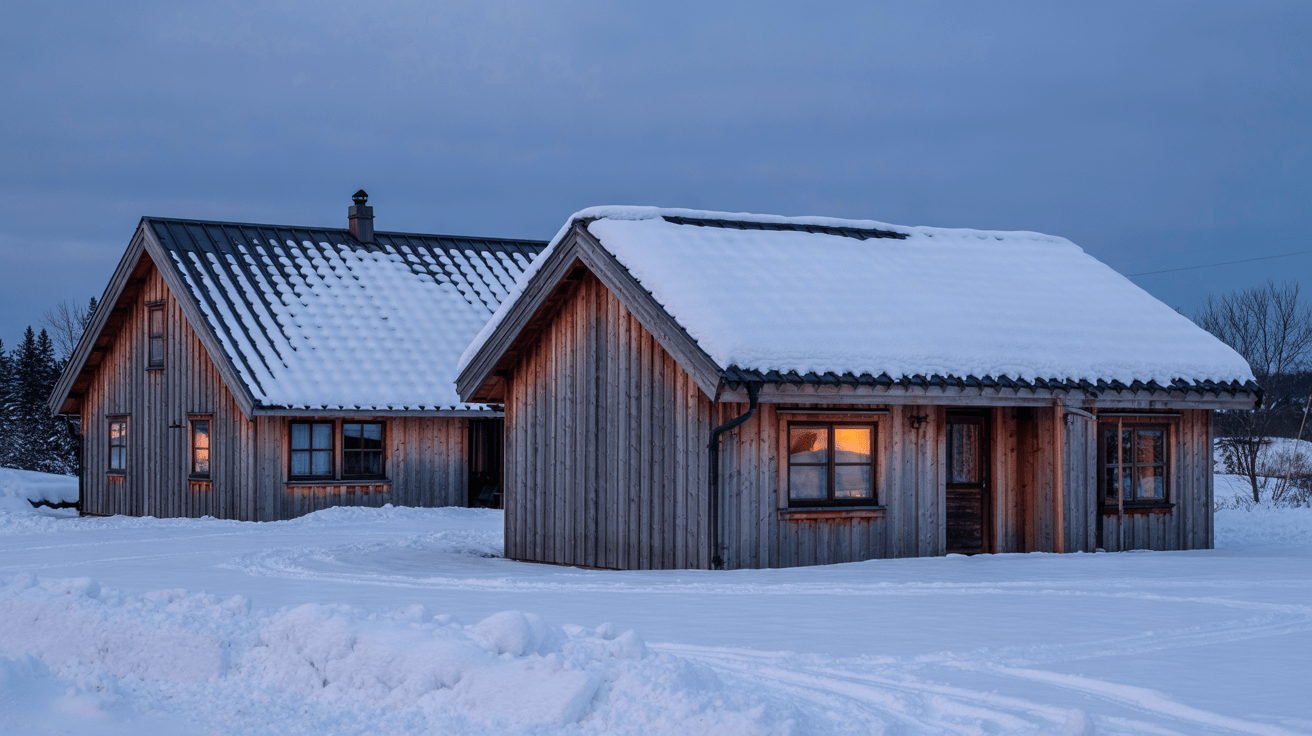
Your roof’s angle determines how much snow weight it carries. This isn’t just technical talk – it’s about keeping your home standing strong when winter hits hardest.
A properly pitched roof manages snow weight distribution like a champ, preventing the costly disasters that can occur when roofs fail under heavy snow.
Understanding Snow Load Calculations
Snow load isn’t just about depth – it’s about weight. And that weight varies tremendously:
Heavy, wet snow can weigh up to 20+ pounds per cubic foot, while light, fluffy snow might weigh just 7 pounds.
The basic formula roofing experts use is:
- Roof snow load = Snow depth × Snow density
Typical snow density ranges:
- Light, dry snow: 7 pounds per cubic foot
- Average snow: 15 pounds per cubic foot
- Heavy, wet snow: 20+ pounds per cubic foot
That means just one foot of heavy, wet snow on a 2,000 square foot roof could add 40,000 pounds of extra weight to your home!
Roof Pitch and Weight Distribution
The angle of your roof dramatically changes how snow accumulates and distributes weight:
- Steeper roofs distribute snow more evenly and shed excess naturally
- Low-slope roofs retain snow, increasing weight risks across the entire structure
When a roof is too flat, snow builds up like books stacked on a shelf – eventually, something has to give. A steeper angle allows snow to slide off before reaching dangerous weight levels.
PRO TIP: For new construction in snow-heavy regions, discuss “live load” calculations with your builder to ensure adequate strength.
Real Risks of a Poorly Pitched Roof
The consequences of getting your roof pitch wrong in snowy climates go beyond minor leaks:
Insufficient pitch can lead to:
- Sagging sections that collect more snow and water
- Structural leaks that damage interior walls and insulation
- In the worst cases, complete roof collapse under extreme snow loads
The news reports of collapsed roofs we see each winter aren’t just freak accidents—they’re often the result of roofs with inadequate pitch for their snow environment.
Recommended Roof Pitches by Snow Severity
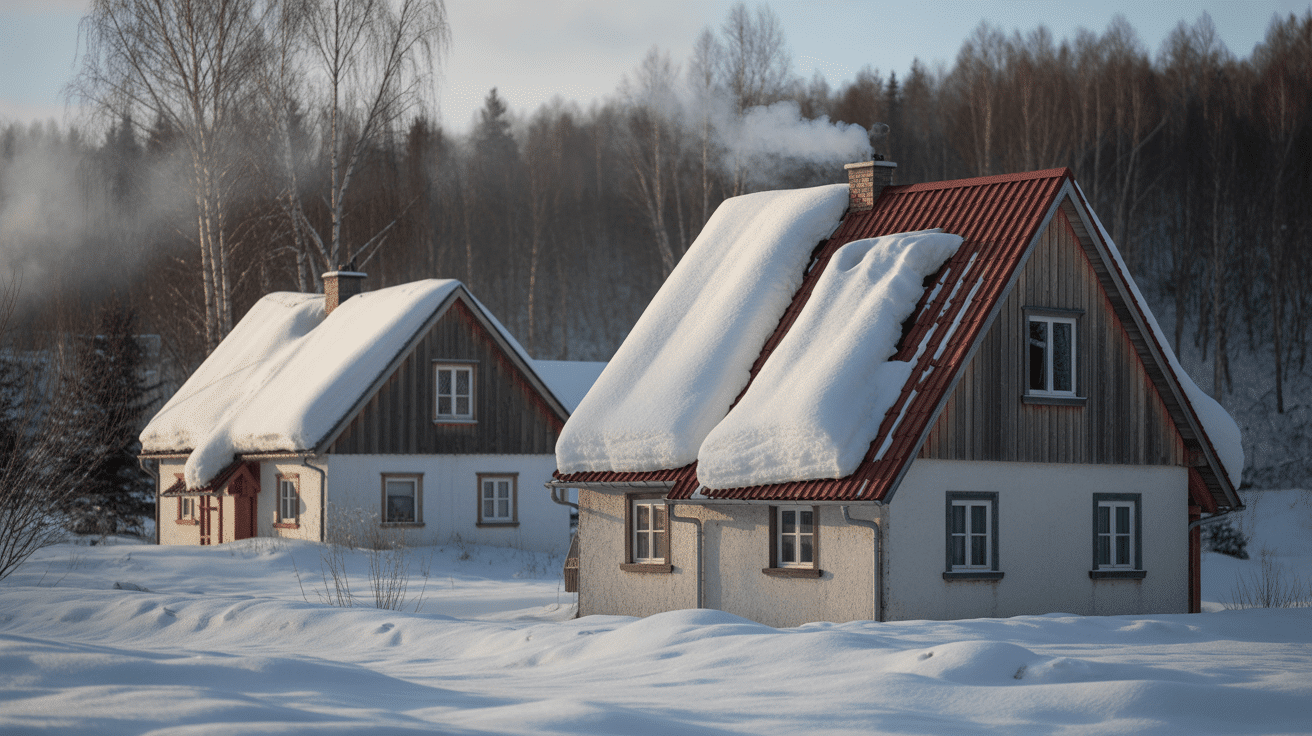
Not all snowy regions are created equal. Your ideal roof pitch depends on how much snow falls in your area each winter.
Light to Moderate Snowfall Regions
In areas with occasional snow or totals under 50 inches annually:
The minimum recommended pitch is 4/12 – that’s a 4-inch rise for every 12 inches of horizontal run.
While you might get away with less steep roofs in these regions, remember that even “light” snow regions can experience occasional heavy storms. Materials and structure remain crucial considerations even with moderate snowfall.
A 4/12 pitch provides a good balance between snow management and building costs in these milder winter zones.
Heavy Snowfall Regions
For areas regularly seeing 70+ inches of annual snowfall:
The ideal pitch starts at 6/12 and often goes steeper to 12/12 for optimal snow shedding.
In these regions, consider adding:
- Snow guards near roof edges to prevent dangerous snow avalanches
- Snow fences to control where and how snow sheds from your roof
The extra cost of a steeper roof is a worthwhile investment in high-snowfall areas, potentially saving thousands in roof repairs and extending your roof’s lifespan.
Local Building Codes & Snow Load Zones
Your local building department has specific guidelines based on historical snow data:
Building codes specify minimum PSF (pounds per square foot) requirements for your specific location. These aren’t suggestions – they’re mandatory safety standards.
Always check with local building departments before any new construction or major roof work in snowy regions. These codes exist because they reflect decades of experience with what works (and what fails) in your specific climate.
Best Roofing Materials for Snowy Conditions
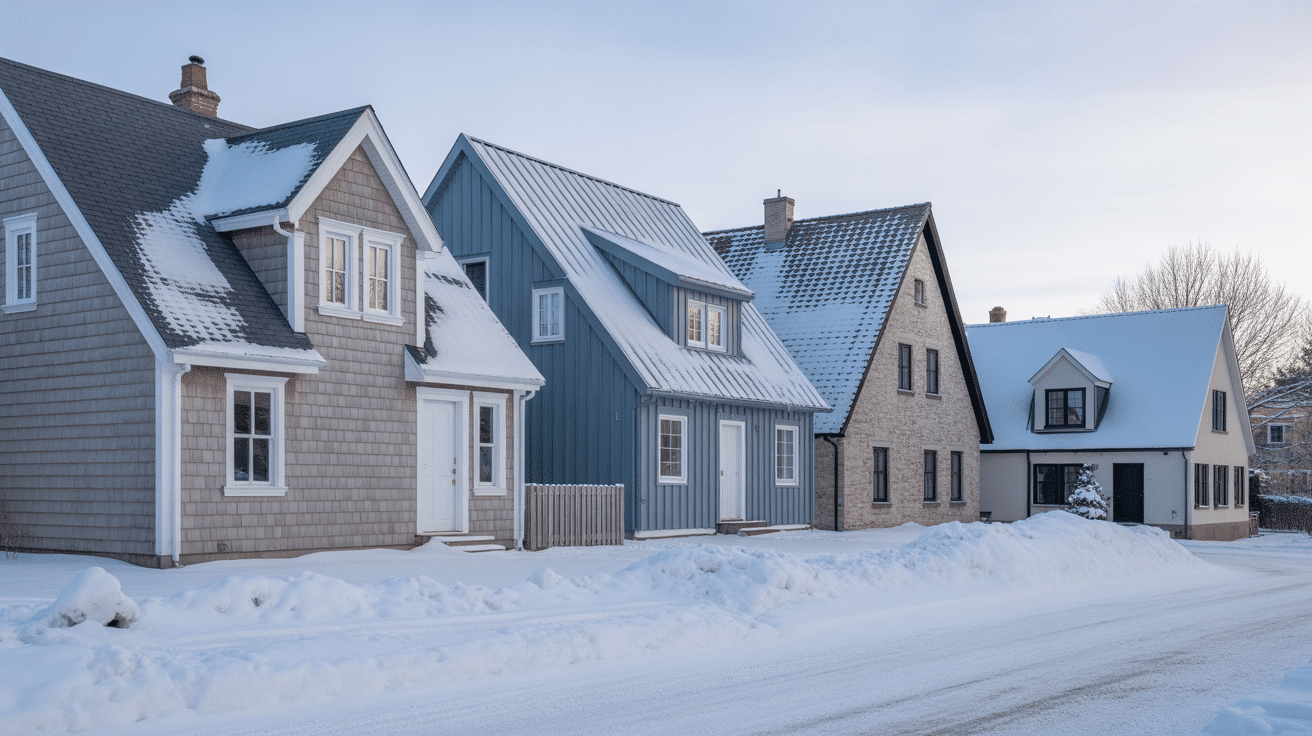
The perfect pitch needs the perfect material. Some roofing options simply perform better when faced with snow, ice, and freeze-thaw cycles.
1. Asphalt Shingles
America’s most common roofing material has mixed results in snowy environments:
Asphalt shingles work best on 6/12+ pitch roofs in snowy regions. On steeper pitches, they provide good performance at a reasonable cost.
However, on flatter roofs, they face increased risks:
- Ice dam formation between shingles
- Potential water backup under shingles
- Granule loss from snow weight and movement
Even structural (dimensional) shingles, while stronger than 3-tab varieties, still need proper pitch to perform well in heavy snow zones.
2. Metal Roofing
Metal has become increasingly popular in snowy regions for good reason:
This material excels from 4/12 to 12/12 pitches, making it versatile for most home designs. Metal’s slick surface creates an excellent snow-shedding surface that minimizes accumulation.
Key benefits in snowy regions include:
- Smooth surface that encourages snow sliding
- Strength that resists denting from ice
- Long lifespan even with repeated freeze-thaw cycles
Standing seam metal roofing, while more expensive initially, often proves most economical over time in heavy snow regions.
3. Slate and Tile
These premium materials offer beauty and longevity, but come with considerations:
Slate and tile are heavy materials that require:
- Steep slope installation (6/12+)
- Reinforced roof structures to support their weight plus snow
While beautiful and extremely durable, these materials face risks of cracking in freeze-thaw cycles if water penetrates beneath them. The additional weight requires careful structural planning when used in snow-prone regions.
4. CeDUR Synthetic Shakes
A modern solution designed with winter challenges in mind:
These synthetic materials perform well at 4/12 pitch or steeper, offering advantages like:
- Lightweight construction that doesn’t add burden to snow-carrying capacity
- Moisture-resistant composition that resists ice dam damage
- Impact and fire ratings that provide additional protection
The synthetic nature of these products makes them resistant to the freeze-thaw damage that affects natural materials.
Snow Management & Prevention Tips for Any Roof Pitch
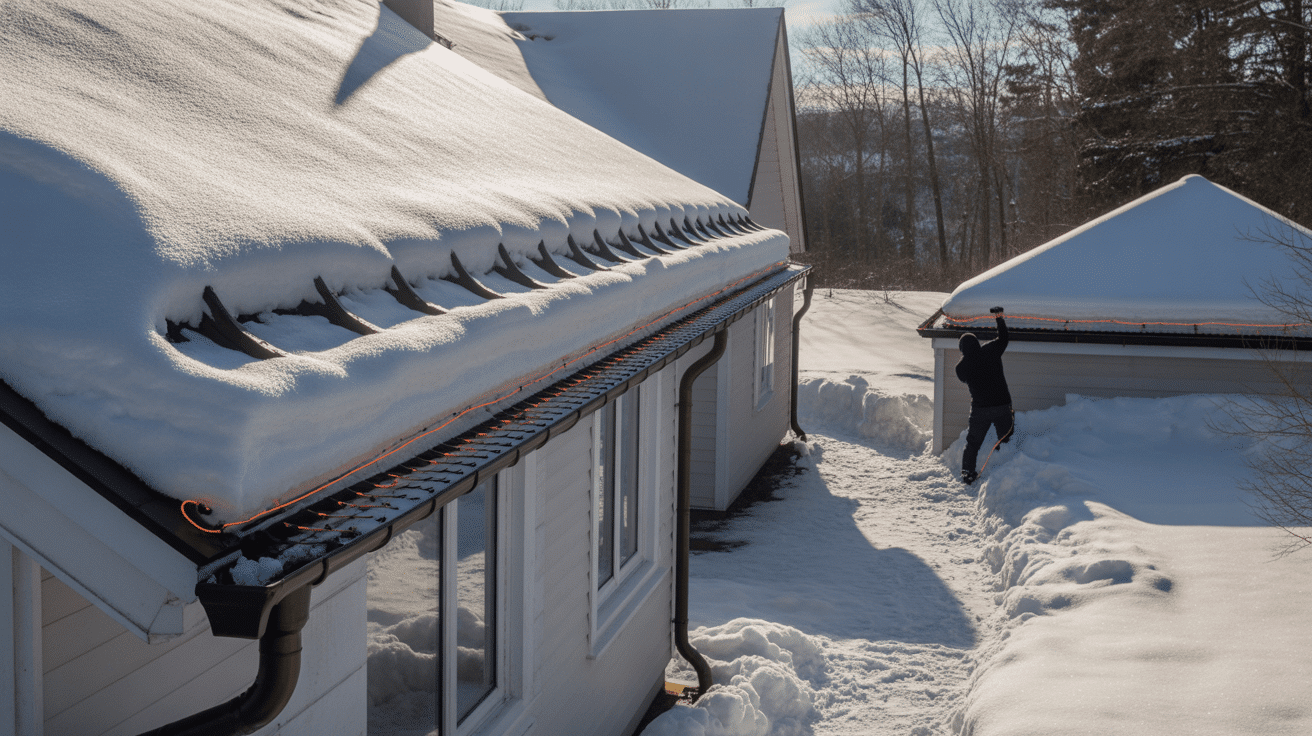
Even the perfect pitch needs proper support systems. These enhancements boost any roof’s snow-handling capabilities.
Snow Guards, Snow Fences, and Heated Cables
These add-ons control how snow leaves your roof:
Snow management systems prevent dangerous snow slides while protecting:
- Gutters from being torn off by sliding snow sheets
- People walking below from avalanche risks
- Lower roofs from impact damage from falling snow
Strategic placement of these devices helps control snow shedding and protects property from damage.
Proper Attic Insulation and Ventilation
The often-overlooked hero in preventing snow damage:
Good insulation and ventilation work together to:
- Prevent uneven roof heating that leads to partial melting
- Minimize ice dam formation at roof edges
- Maintain consistent temperatures across the roof surface
Many snow-related roof problems actually start inside your attic, not on the roof surface. Proper temperature regulation prevents the melt-freeze cycle that creates damaging ice dams.
PRO TIP: Schedule an attic inspection before winter to add ventilation and seal heat leaks that cause ice dams.
Gutter and Downspout Maintenance
Clear water paths prevent ice buildup:
Regular gutter maintenance ensures:
- Melted snow drains efficiently away from the roof edge
- Water doesn’t back up and refreeze into ice dams
- Downspouts direct water safely away from the foundation
Fall gutter cleaning becomes even more critical in snowy climates, as any debris can create ice blockages during winter thaws.
Flat Roof Considerations
If you already have a flat or low-slope roof in a snowy region:
You’ll need supplemental measures including:
- Extra insulation to prevent uneven melting
- Careful sealing of all potential water entry points
- Supplemental heat cables at drainage points
- Regular snow removal during heavy accumulation
While not ideal for snow, flat roofs can function with proper design and vigilant maintenance.
Final Considerations When Choosing Roof Pitch for Snow
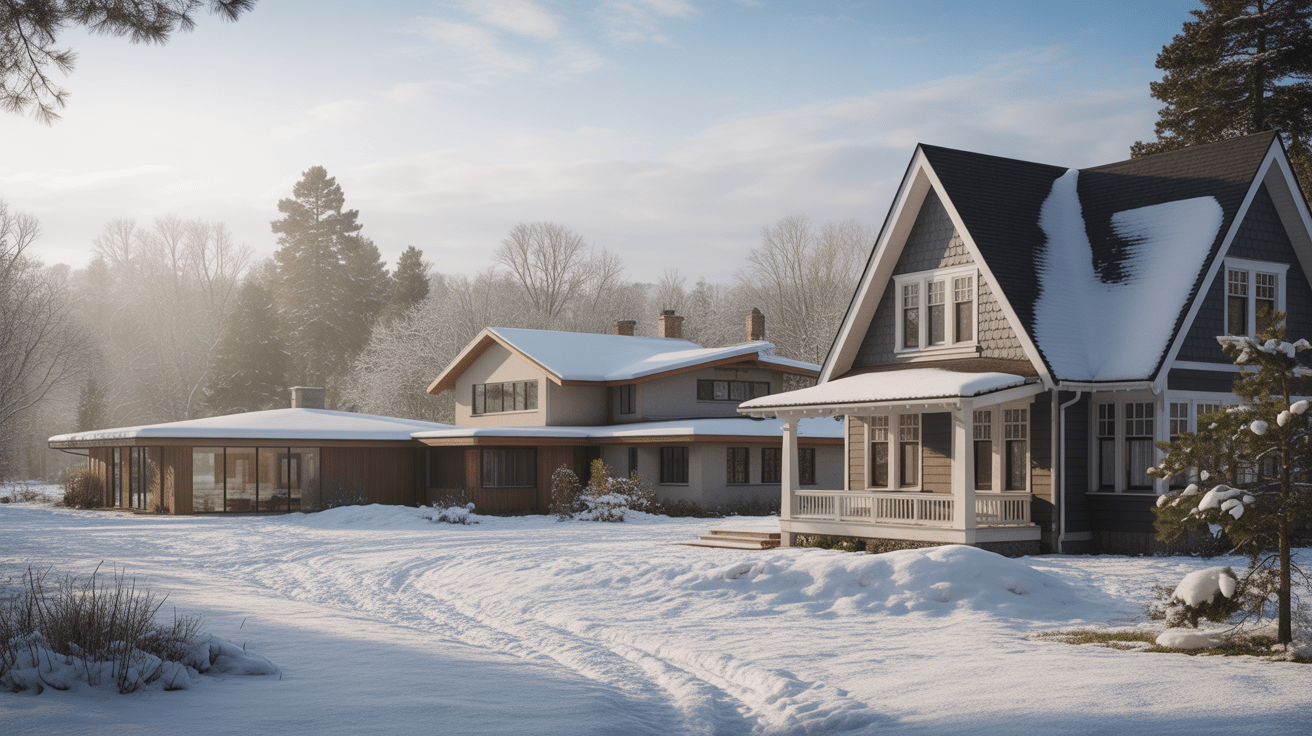
Beyond technical specs, your roof choice should balance practical needs with stylistic goals.
Match Roof Pitch with Structural Style
Your roof should complement your home’s overall design:
Different structural styles naturally pair with different roof pitches:
- A-frames (12/12 pitch) excel in snowy regions with their extreme slope
- Modern homes with flat or low-slope roofs require special snow-management considerations
Finding the sweet spot between your preferred style and snow-safe function often requires creative structural solutions.
Form or Function? Choose Wisely
In snow country, practical concerns should lead decision-making:
While flat and low-slope roofs create a sleek, modern look, snowy regions demand prioritizing function over style. The good news? Steeper traditional pitches can create timeless appeal while providing superior snow protection.
| Style Preference | Functional Snow Performance | Recommended Compromise |
|---|---|---|
| Modern Flat Roof | Poor snow handling | Low-slope (3/12) with enhanced structure and heating elements |
| Mid-century Modern | Moderate snow handling | 4/12 pitch with wide overhangs |
| Craftsman/Bungalow | Good snow handling | 6/12 pitch (historically accurate) |
| Victorian/Colonial | Excellent snow handling | 8/12-12/12 pitch (authentic to style) |
| A-Frame | Superior snow handling | 12/12 pitch (form follows function) |
Beautiful design and snow safety aren’t mutually exclusive – they just require thoughtful planning.
Maintenance Frequency Based on Slope
Your roof’s pitch directly impacts your winter maintenance routine:
- Steep roofs (8/12+) require less manual snow clearing but need stronger structural support
- Low-slope roofs (4/12) demand higher maintenance and regular snow removal
Consider your willingness and ability to maintain your roof when choosing a pitch. A steeper roof might cost more initially but save countless hours of winter maintenance.
In snow country, the right roof isn’t just about staying dry – it’s about peace of mind through the longest, snowiest winters.
Wrapping It Up
The right roof pitch changes winter from a threat into a beautiful backdrop for your home life. Proper angles create peace of mind when the forecast calls for heavy snow.
Your region’s snowfall patterns, your home’s structural style, and your roofing material all play crucial roles in determining the ideal pitch.
Remember that even the perfect pitch requires proper support systems. Insulation, ventilation, and occasional maintenance work together with your roof’s angle to create a complete winter protection package.
This invisible guardian deserves careful consideration at every stage, whether it be new construction or a renovation.
What’s your roof’s snow-handling score? Share a photo in the comments and let our community weigh in on its winter readiness!

